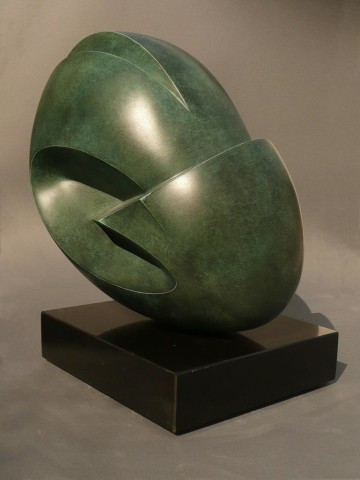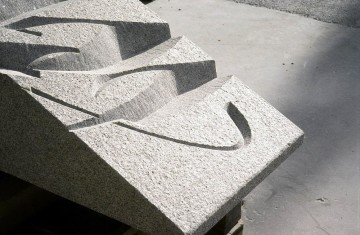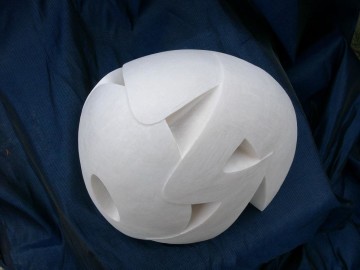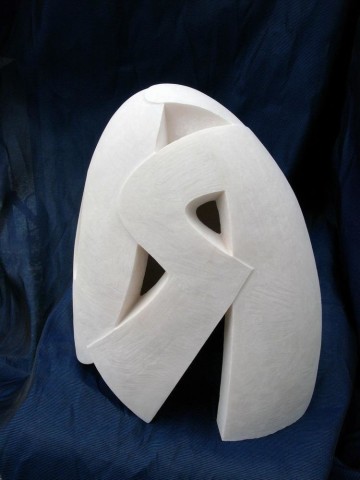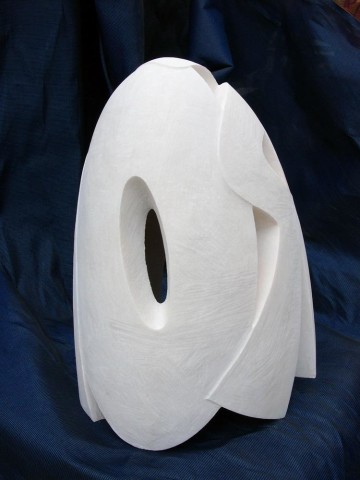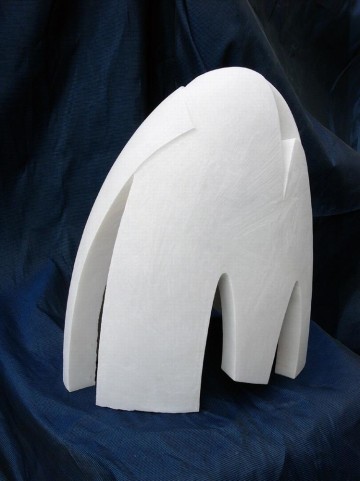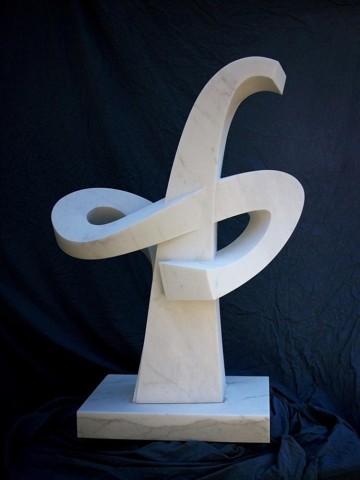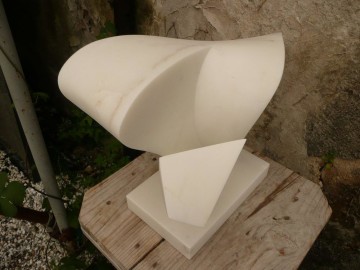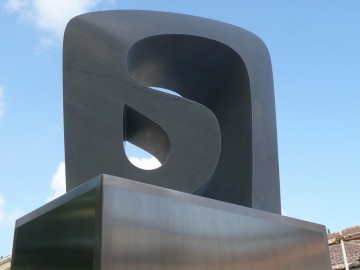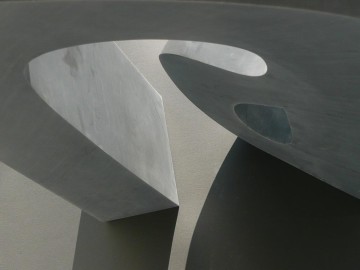Julia Vance
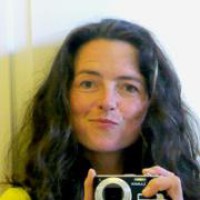
Julia Vance
Pietrasanta, Italy
Calligrapher, sculptor
My story from paper to letters in 3-D
After having made letters and words on paper and as inscriptions in stone (relief work) for more than ten years…I wanted to see behind and around the lettershapes. I wanted to give the letters more body, to walk around a word, climb through a letter or even carry a word in my arms. How could I also catch the movement of a hand executing the letters?
So I left my home in Norway, and today live and work in Italy in a small village in Tuscany called Pietrasanta. This is in the region of Carrara where one has taken out marble for the past 3000 years. Today Pietrasanta is full of sculptors from all over the world using the beautiful marble in their artistic work.
Today I make my letter-sculptures in mainly marble, but also in bronse. I use letters, symbols, words and sometimes even only parts of letters. I seek to give these figures a physical body, to make them have presence and life.
In my letter-sculptures I try to capture the movements of the strokes of the letter, perhaps ephasizing changes of directions or connections. I may toss and turn the figure to an unrecognisable shape. Through my word-sculptures I investigate in the meaning of special words, words that for me carry a whole story within themselves. This can be words like; enough, us and no.
Author works
VI — bronze
...‘VI’ means ‘US’ in Norwegian, and the two letters in the word ‘VI’ are what this sculpture physically is made up of. The two capitals are like two individuals which together can make an ‘us’. They form a unity by slightly overlapping eachother. The letter tops continue up and around to the sculpture’s back, where they grow together into one. As they arrive up again below the letters they seem like a blanket covering their own feet. The letters in their togetherness are in themselves protected. The blanket is soft but also tight, letting nobody else slip into this unity.Bronze, 40 x 30 x 40 cm, 2007
VI — White marble
...‘VI’ means ‘US’ in Norwegian, and the two letters in the word ‘VI’ are what this sculpture physically is made up of. The two capitals are like two individuals which together can make an ‘us’. They form a unity by slightly overlapping eachother. The letter tops continue up and around to the sculpture’s back, where they grow together into one. As they arrive up again below the letters they seem like a blanket covering their own feet. The letters in their togetherness are in themselves protected. The blanket is soft but also tight, letting nobody else slip into this unity.Marble
Tenketid
‘tenketid’ is how you would say ‘time to think’ in Norwegian. If you sit on the sculpture for a while, as if it were a bench, then the word ‘tenketid’ will be imprinted to your back side when you get up. This sculpture was exhibited in front of the Norwegian Parliament in 2005.Grey Iddefjord Granit, 50x150x45cm, 2005
MOЯ
’MOЯ’ is the Norwegian word for ‘mother’. First you see the ‘R’ as back to front, inclining that you may go into the piece and read it from inside. From inside the sculpture you can read it as ‘ROM’, which is the Norwegian word for ‘room/space’.White Afyon marble, 69x41x54cm, 2006
MOЯ
’MOЯ’ is the Norwegian word for ‘mother’. First you see the ‘R’ as back to front, inclining that you may go into the piece and read it from inside. From inside the sculpture you can read it as ‘ROM’, which is the Norwegian word for ‘room/space’.White Afyon marble, 69x41x54cm, 2006
MOЯ
’MOЯ’ is the Norwegian word for ‘mother’. First you see the ‘R’ as back to front, inclining that you may go into the piece and read it from inside. From inside the sculpture you can read it as ‘ROM’, which is the Norwegian word for ‘room/space’.White Afyon marble, 69x41x54cm, 2006
MOЯ
’MOЯ’ is the Norwegian word for ‘mother’. First you see the ‘R’ as back to front, inclining that you may go into the piece and read it from inside. From inside the sculpture you can read it as ‘ROM’, which is the Norwegian word for ‘room/space’.White Afyon marble, 69x41x54cm, 2006
f
In ‘f’ I seek to capture the sward swaying movement of the hand executing a letter ‘f’. Like the energy of blood rushing through a vein. I create lettershapes, sometimes only part of a letter. I see the lines and shapes as possible human expressions. Letters can be read or just seen as shapes, or both. They are common in that they belong to everyone. But they are also made personal each time a hand executes them.Carrara Bianoco Marble, 115x80x35 cm, 2007
"Du"
‘Du’ is the Norwegian word for ‘you’. If you write with your hand in the air, not depending on a surface to leave the traces on, then you make a certain hand movement, a known pattern of changing directions, pressure and speed. These movements I seek to capture in stone. This is a word which carries for me a long story of thoughts.White Statuario marble, 30x40x25 cm, 2008
Du
‘du’ is the Norwegian word for ‘you’. If you write with your hand in the air, not depending on a surface to leave the traces on, then you make a certain hand movement, a known pattern of changing directions, pressure and speed. These movements I seek to capture in stone. This is a word which carries for me a long story of thoughts.White Statuario marble, 30x40x25 cm, 2008
@
The symbol of ‘@’ enables us today to communicate by e-mail across the World instantly. In this sculpture I play with the shape and the idea of the ‘@’. The material is millions of years older than the symbol. This piece of sculpture will never fly through the internet.Grey Bardiglio Marble, base in stainless steel, Hight sculpture 50cm, hight base 110cm, 2008
@ from above
The symbol of ‘@’ enables us today to communicate by e-mail across the World instantly. In this sculpture I play with the shape and the idea of the ‘@’. The material is millions of years older than the symbol. This piece of sculpture will never fly through the inter-net.Grey Bardiglio Marble, base in stainless steel, Hight sculpture 50cm, hight base 110cm, 2008
Calligraphy is a kind of music not for the ears, but for the eyes.
(V. Lazursky)
